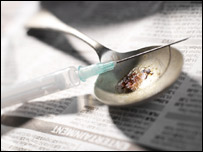Heroin Addiction

 Heroin addiction has a long history dating as far back as 6,000 years ago. It is the most abused opiate in the world as well as the fastest acting. In its pure form, heroin is typically a white powder. However, it is often found in less pure forms and will vary in color from white to brown. There is also a form of heroin known as "Black Tar". This type of heroin is dark brown or even black in color. It is sticky and resembles tar, hence its name.
Heroin addiction has a long history dating as far back as 6,000 years ago. It is the most abused opiate in the world as well as the fastest acting. In its pure form, heroin is typically a white powder. However, it is often found in less pure forms and will vary in color from white to brown. There is also a form of heroin known as "Black Tar". This type of heroin is dark brown or even black in color. It is sticky and resembles tar, hence its name.
Heroin addiction affects the user both mentally and physically. The addict not only craves the drug to feel good, but needs it to avoid withdrawal symptoms. This becomes a double edged sword for those individuals who try to end their heroin addiction.
There are many heroin addiction signs. In the beginning, the user will typically experiment just once or twice a week or in some cases less often, such as once a month or less. When an user is in the beginning stages of heroin addiction and directly injection into a vein [mainlining], the most accessible veins are generally used. These veins are located in the inner portion of the arm near the elbow joint. This injection site is commonly called "the ditch" by users. If the person is mainlining, you may see scabs on these veins.
As the user progresses from experimentation to heroin addiction, they will eventually reach a point where they shoot up at least once a day. At this time, several injection sites become noticeable. For example, over a 6 month period, the user will have shot up at least 180 times. This is when the needle marks manifest themselves as "tracks." Trails of tiny scabs may extend 1-3 inches or more down the arm or leg in a straight line right over top of the vein.
People with heroin addiction problems build up a tolerance to the drug's effects very quickly. A tolerance to heroin or any other drug means that the user must take more of the substance to achieve the same effect that a smaller amount did initially. Once someone has become addicted to heroin they no longer know how to function without being high and will experience extreme withdrawal symptoms if they stop taking the drug.
Users with a serious heroin addiction problem may develop collapsed veins, infection of the heart lining and valves, abscesses, cellulites, and liver disease. Pulmonary complications, including various types of pneumonia, may result from the poor health condition of the abuser as well as from heroin's depressing effects on respiration.
Heroin abusers have made a recent shift from injecting the drug to snorting and smoking it. They are under the impression that by not injecting the drug they will avoid heroin addiction. This is not the case. Everyday more and more people succumb to heroin addiction. Those who inject the drug run the risk of contracting HIV or other blood born diseases. This happens when a heroin users shares needles or other injection equipment with an infected individual. Often, addicts are unaware of their health problems and share their contaminated paraphernalia without knowing the serious consequences.
Heroin Information
- Signs of Heroin Use
- Social Effects of Heroin
- Heroin and Health Risks
- Heroin History
- Injecting Heroin
- Smoking Heroin
- Heroin Statistics
- Black Tar Heroin
- Heroin Pictures
